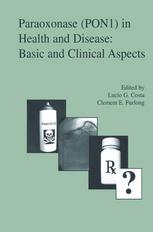

Most ebook files are in PDF format, so you can easily read them using various software such as Foxit Reader or directly on the Google Chrome browser.
Some ebook files are released by publishers in other formats such as .awz, .mobi, .epub, .fb2, etc. You may need to install specific software to read these formats on mobile/PC, such as Calibre.
Please read the tutorial at this link: https://ebookbell.com/faq
We offer FREE conversion to the popular formats you request; however, this may take some time. Therefore, right after payment, please email us, and we will try to provide the service as quickly as possible.
For some exceptional file formats or broken links (if any), please refrain from opening any disputes. Instead, email us first, and we will try to assist within a maximum of 6 hours.
EbookBell Team

4.8
64 reviewsThe paraoxonase or PON family of genes resides on human chromosome 7q2t-22 in the order PONt, PON3 and PON2. PONt was one of the early genes identified as an environmentally relevant gene, in that it is important in determining an individual's sensitivity or resistance to exposure from specific organophosphorus (OP) insecticides. Paraoxonase (PONt) is an A esterase (i. e. , not inhibited by OP compounds) initially identified for its ability to catalytically hydrolyze paraoxon, the toxic metabolite (oxon form) of the insecticide parathion. Evidence accumulated in the past several years has established that this enzyme, which is present at variable levels in liver and serum of different individuals, is an important determinant of sensitivity to toxicity of specific organophosphorus compounds including chlorpyrifos oxon and diazoxon. Recent experiments have pointed out that it is the catalytic efficiency of PONt together with the levels of PONt that are important in determining the degree of resistance. Surprisingly, even though PONt has a higher catalytic efficiency than PONtQ)92 for paraoxon RJ92 hydrolysis, it does not provide significant in vivo protection against an exposure to paraoxon. Interest in this enzyme has also emerged from the finding that it displays genetic polymorphisms in most populations, with a significant number of the individuals in a given population canying a PONt gene that puts them at risk for a specific OP exposure.